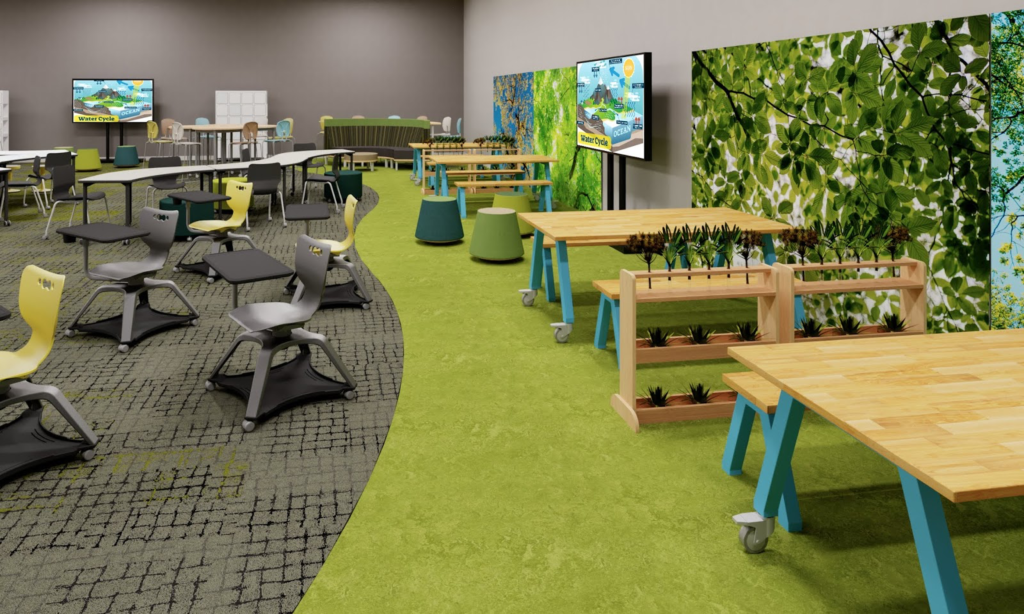Putney High School commissioned a 9 month study into the impact of biophilic design within classrooms as part of their ‘Breathe’ campaign. Biophilic design is the increase in occupant connectivity to the natural environment through the use of direct nature, indirect nature, space and place conditions.
The study began with the transformation of three otherwise similar Sixth Form classrooms. The first, a maths classroom was modified with an extensive array of indoor plants, the second an English classroom, with a full-size photographic wall mural of a woodland, and the last, a Psychology classroom, was left unchanged. All three classrooms were monitored for air quality and atmosphere, and observed for concentration levels and feelings of wellbeing of the staff and students that spent time in them.

There is a raft of research into how spending time outdoors, fresh air and nature and benefiting physical and mental wellbeing reducing stress, anxiety and depression to name just a few. The challenge was to integrate this to a classroom environment, particularly in a busy London based school. “The importance of plants in cleaning the air has been known for a long time,” said Mrs Longstaff, “but we didn’t realise just how much until we had completed our research. Not only have the plants measurably enriched the oxygen for staff and students, the plants have also had a significant effect on psychological wellbeing.”
The results were impressive after four months, 78% of pupils reported that they actually ‘felt healthier’. Not only did the study demonstrate a measurable improvement in brain boosting oxygen, perhaps more interestingly, it showed a marked change in the behaviour and perceptions of those involved. Students commented on how the classrooms were so much more “relaxing”. “The plants really have a calming effect. They change the atmosphere for sure,” said Sophia, a Year 13 student who was actively involved in caring for the plants.
The study showed that during the Winter Term the classroom with plants provided improved comfort by 10%, and humidity improved 8% above the ‘natural analogue classroom’ The occupant survey found that 65% of students were content. 68% of students liked the wall mural, and 62% liked having plants in the classroom. The surveys revealed the use of plants had a closer association with occupant cognitive wellbeing, while the mural of nature was the preferred biophilic intervention, with a stronger relationship with emotional wellbeing.

The study highlighted that Teacher involvement and engagement is key to re-introducing plants to learning environments. This ensures that plants remain healthy and the presence of insects are controlled. The plants used in the study and their benefits are listed below:
| INDOOR PLANT | ENVIRONMENTAL QUALITIES |
| Areca palm Chrysalidocarpus lutescens | A graceful palm which releases copious amounts of moisture into the air and removes chemical toxins such as formaldehyde, xylene and toluene |
| Dragon tree Dracaena marginata | Copes well in low light levels, it is also a particularly effective air cleaner to remove xylene and trichloroethylene. |
| Peace lily Spathiphyllum sp. | Has high transportation rates, it also excels in the removal of alcohols, acetone, trichloroethylene, benzene and formaldehyde. |
| Epipremnum aureum & Heart-leaf philodendron philodendron oxyycardium | Thrives in shade and removes chemical vapours; was introduced as a house plant in 1850. |
| Anthurium Anthurium andraeanum | Out of all the plants the anthurium thrived in the classroom and bloomed twice and their flowers were a visual highlight. |
| Snake plant Sanserviera trifasciata | One of most resilient plants for classrooms it produces oxygen and reduces carbon dioxide at night. |
| Aloe vera Aloe barbadensis | Known for its medicinal properties it also releases oxygen and absorbs carbon dioxide at night. |
| Moth orchid Phalenopsis sp. | Thrive in warm humid environments; flowering plants were introduced during the exam period. They are effective in removing xylene from the atmosphere. |
| Spider plant cholorophytum cosmosum | The plant received worldwide attention in 1984 when NASA released research findings showing its ability to improve indoor air quality. |
Green infrastructure (GI) has been shown to be beneficial to health and wellbeing;
it decreases stress, improve levels of productivity and creativity, while also reducing absenteeism and ‘presenteeism’, and reduces illness. Schools have demonstrated that children learn 20-25% faster when natural light is present.
Any classroom can feature biophilic design elements
Your classroom doesn’t need to be large, well-lit, or perfectly equipped to be a biophilic classroom. Whether by adding natural imagery or patterns, live plants, more natural lighting, a biophilic colour palette, or more natural shapes and flow, any classroom can bring the benefits of the great outdoors, indoors.
Many schools have spent time creating learning spaces on their grounds. Whether the space is permanent or temporary, used daily or just for specific lessons, moving the whole class outside offers students a multisensory immersion in nature.

For stressed-out students at a tumultuous time, the benefits of biophilic design have never been more important: lower stress, sunnier moods, sharper focus, greater retention, and more kindness. Maybe we could all use a little more contact with nature.
At PH Sports we have been actively bringing plants into our office spaces and will be looking to utilise the our knowledge gained to introduce other biophilic design ideas into our spaces to improve wellbeing, concentration, comfort and healthier.
Use the link below for access to the full report
https://www.gdst.net/wp-content/uploads/2021/03/Biophilic-report-for-website-1.pdf
